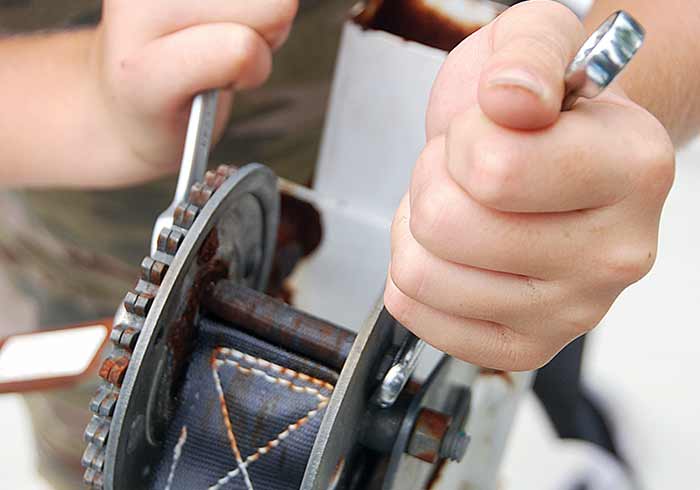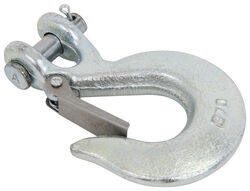To attach a hook to a winch strap, thread the strap through the eye of the hook, then secure it using a heavy-duty bolt or pin. Make sure the hook’s latch is functioning and the strap is rated for the intended load. This ensures a secure towing setup and prevents slippage or failure during use.
Quick Answer
How Do You Attach a Hook to a Winch Strap?
To attach a hook to a winch strap:
- Thread the winch strap through the hook’s eye.
- Fold the strap back to create a secure loop.
- Pass the remaining strap through the loop.
- Pull the strap tight to secure the hook firmly.
- Test the connection by tugging the hook to ensure it won’t slip.
Tools and Materials Required
Before we dive into the specifics, let’s talk about what you’ll need:
- Best Winch strap: The backbone of your operation, designed to bear the load. Ensure the load capacity of your winch strap matches the intended use to prevent failure.
- Compatible hook: The connector that links your load to the winch strap. Consider the alignment of your boat or trailer to simplify the attachment process.
- Protective gloves: Essential for keeping your hands safe from cuts and abrasions.
- Cutting tool: Handy for trimming the winch strap to the perfect length.
Preparing the Winch Strap
A little prep work can go a long way in ensuring a successful attachment:
- Inspecting the winch strap: Check for any signs of wear or damage. A compromised strap could fail under load, leading to dangerous situations.
- Check for fraying or uneven tension spots to ensure the strap can handle heavy loads.
- Cleaning the winch strap: Remove any dirt or debris that could weaken the strap’s integrity.
- Measuring and cutting the winch strap: If your strap is too long, cut it down to size. Remember, it’s all about precision and effectiveness.
Attaching the Hook to the Winch Strap

1. Threading the Winch Strap Through the Hook’s Eye
This initial step might seem simple, but it sets the stage for a successful attachment. The hook’s eye is the circular or oval opening at one end of the hook.
You start by taking one end of the winch strap and sliding it through this eye. The goal is to have enough strap going through the eye to create a secure loop.
Ensure the hook is compatible with your winch strap’s material and width for optimal safety.
It’s like threading a needle; the strap must go through the eye smoothly without fraying or getting caught.
This is where using protective gloves comes in handy, as they protect your hands from any sharp edges on the hook or strap.
2. Creating a Loop With the Winch Strap
After threading the strap through the hook’s eye, the next step is to fold the strap back onto itself, creating a loop.
Maintain a consistent loop size across attachments to ensure uniform load distribution.
This loop is crucial because it’s what you’ll use to secure the strap to the hook, ensuring that it doesn’t slip off under load.
The size of the loop can vary, but it should be large enough to handle easily and tight enough to secure the hook firmly. This balance is key to a reliable attachment.
3. Passing the Remaining Strap Through the Loop
Now, with the loop made, you take the part of the strap that’s been threaded through the hook’s eye and pass it through the loop you just created.
This might sound a bit tricky, but it’s essentially making a simple knot. The act of passing the rest of the strap through the loop you’ve made starts to form the basis of a secure attachment.
This step is about tightening and securing the strap to ensure the hook is firmly attached.
4. Pulling the Strap Tight
With the strap passed through the loop, you now pull it tight. This action secures the knot you’ve created and ensures the hook is firmly attached to the winch strap.
Pulling the strap tight is critical; the tighter the strap, the more secure the hook. Avoid over-tightening, as it could weaken the integrity of the strap’s fibers.
However, it’s important to pull evenly and smoothly to avoid damaging the strap. The strap should not be twisted or pinched, as this could weaken its integrity.
5. Testing the Connection
The final step in the process is testing the connection you’ve just made. This means pulling the strap firmly to ensure that the hook is securely attached and the knot isn’t slipping.
Testing the connection is vital for safety. Inspect the knot visually for signs of slipping or loosening under tension.
If the hook comes loose during operation, it could lead to a dangerous situation.
This step is about ensuring that your attachment can handle the load it will be under during use.
Common Mistakes to Avoid
Even with the correct attachment method, certain mistakes can compromise the safety and durability of your setup. Here are the most common errors to watch out for:
- Using a hook incompatible with your strap’s width or material: An ill-fitting hook can lead to poor load distribution and potential slippage during operation.
- Over-tightening the strap: Excessive tension can weaken the fibers of the strap, reducing its lifespan and making it prone to failure.
- Ignoring visible signs of strap damage: Small tears, fraying, or wear marks may seem insignificant but can quickly escalate into catastrophic failures under load.
By avoiding these pitfalls, you can ensure your winch system performs reliably and safely.
Why This Process Matters
This detailed process of attaching a hook to a winch strap may seem like a lot of steps for a seemingly simple task. However, each step is crucial for ensuring the safety and effectiveness of your winching operations.
A secure attachment means that the load you’re winching is safely connected, reducing the risk of accidents or damage.
It’s a fundamental skill that underpins safe winch use, ensuring that you can operate with confidence knowing that your equipment is correctly and securely assembled.
Alternative Attachment Methods
Sometimes, a direct attachment isn’t the best option. Here’s where alternatives come into play:
Winch Hook with a Built-in Clasp

A winch hook equipped with a built-in clasp offers a significant upgrade in terms of security and convenience over traditional hooks.
This type of hook features a spring-loaded clasp that can easily be opened and closed, securing the hook to the winch strap without the need for tying knots.
Benefits
- Enhanced Security: The built-in clasp locks the hook onto the strap, preventing it from slipping off even under heavy loads or vibration. This is crucial for applications where the winch is used in moving vehicles or in situations with a lot of movement.
- Ease of Use: Attaching and detaching the hook becomes a quick and simple process, which is especially helpful in situations where time is of the essence or when frequent changes are required.
- Reduced Wear: Since there’s no need to tie and untie knots, both the strap and the hook are subject to less wear and tear, extending their lifespan.
- Built-in clasps are particularly useful in situations involving frequent load changes, such as boat launches with steep ramps or rough terrain. They reduce the need for manual adjustments and improve efficiency.
Attaching the Hook Using a Shackle or Carabiner
For situations that demand even greater flexibility and strength, using a shackle or a carabiner to attach the hook to the winch strap is an excellent alternative.
Both shackles and carabiners are designed to provide a secure link that can easily be opened and closed, making them perfect for applications where the hook needs to be moved or replaced often.
Benefits
- Versatility: A shackle or carabiner allows for quick changes between different hooks or attachment points, offering flexibility across a wide range of applications.
- Strength: Both shackles and carabiners are made from materials capable of handling high loads, making them suitable for heavy-duty winching tasks.
- Security: The locking mechanism on a shackle or carabiner ensures that the hook remains securely attached to the winch strap, minimizing the risk of accidental detachment.
- Opt for marine-grade shackles or carabiners for extended durability in marine environments, such as saltwater applications or frequent boating, where corrosion resistance is critical.
Considerations
When choosing to use a shackle or a carabiner, it’s important to consider the load capacity and compatibility with your winch strap and hook.
Ensure that the chosen accessory can handle the maximum load you plan to winch. Additionally, the locking mechanism should be reliable and easy to operate, even in challenging conditions or with gloves on.
Why Choose Alternative Attachment Methods?
Opting for a winch hook with a built-in clasp or attaching the hook using a shackle or carabiner can greatly enhance the safety, efficiency, and flexibility of your winching operations.
These methods allow for quick adjustments, provide a more secure connection, and reduce wear on your equipment.
Whether you’re involved in rescue operations, off-roading, or any activity requiring the use of a winch, considering these alternatives can lead to a safer and more effective outcome.
Safety Tips
Last but not least, let’s talk about safety:
- Double-check your attachment before putting it to use. Better safe than sorry.
- Regular inspections are key to spotting potential issues before they lead to failures.
- Adhere to weight capacity limits to avoid overloading your winch and strap.
- Wear protective gloves to keep your hands safe during the process.
Also check: How to Properly Attach a Strap to a Winch
Conclusion
Attaching a hook to your winch strap may seem straightforward, but its importance cannot be overstated. It’s the link that holds everything together, literally.
By following the guidelines outlined above and adhering to safety practices, you can ensure a reliable and safe winch use every time.
By following these steps and adhering to safety guidelines, you can ensure a secure and reliable attachment for various winching applications, whether off-roading or boat trailering.
So, gear up, stay safe, and get to winching with confidence.

